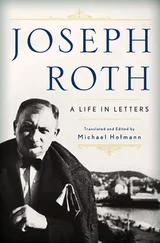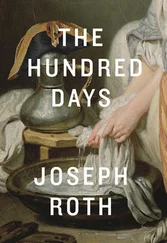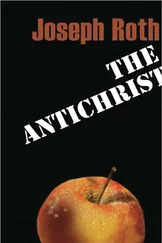Of the major players in the book, the one who is least clearly described is Frau Perlefter. We never even learn her first name. Neither do we get a physical description either (aside from ‘an awkward girl, no longer young and not pretty’); we get to see her personality mainly through her actions not through the narrator’s or Perlefter’s description. She seems to be quite weak and prone to outbursts; the only sign we get of her cunning is early on, via flashback, when Kroj mentions that Perlefter ‘fathered children against his will’. She lurks in the background through the rest of the book, coming forth to burst into tears once in a while or feel ill. Although Perlefter himself would like to claim the title, Frau Perlefter seems to be the family martyr. It is interesting to note that not long before Roth began writing Perlefter his wife began to exhibit the signs of the schizophrenia that would ultimately lead her being institutionalized. It is not inconceivable that some of Frau Perlefter’s behaviour is drawn from that which Roth observed in his own wife.
The Perlefter children are comically drawn. They are not given the same detailed consideration as Perlefter himself, but Roth is masterful at accomplishing much in a short space. Each Perlefter child has his or her own particular faults (whether foolishness or vanity or even intelligence), and, although seemingly hopeless at first, each one seems to achieve some measure of maturity and redemption by the close of Chapter VII. Roth devotes the most energy to Fredy, who is a classic wealthy and indifferent bourgeois, as are his friends.
In Perlefter affluence leads not to happiness but to insecurity, indecision, dissatisfaction and even boredom. Perlefter desires to marry off his children well, yet when he achieves this dream and his son marries into a very wealthy family under the surface he is actually not happy; he is jealous. Herr Kofritz is too rich, too influential, and it annoys Perlefter to have to brag about this new in-law. And in what must also be bothersome to Perlefter, Herr Kofritz steals Fredy away by taking the young man into his thriving leather business.
Yes, happiness is elusive for the entire Perlefter clan. The only one who seems happy in the book is Leo Bidak, who does not let anything ruin his mood (Kroj would be happy if only he could be with Henriette). Leo Bidak is decidedly not bourgeois. He has not achieved that status, not even with his half-house, and his lack of business skills and participation in socialist activities further removes him from bourgeois status. Bidak’s ineptitude with money causes him to lose his half of the house. Life has scoffed at Leo Bidak, yet he does not care.

In total, the original manuscript of Perlefter consists of thirty-two pages. Written in Roth’s characteristic tiny handwriting, it is messy in spots, over-inked in some places and faint and faded in other spots. Yet, considering its status as an unfinished work it is surprisingly clean. There are strike-outs of words and phrases here and there and only occasionally whole sentences (in fact, in the entire manuscript of almost 30,000 words there are only twelve instances where Roth crossed out an entire sentence), but never a whole paragraph. Most are isolated incidents except for a couple of places — for example, near the end of Chapter II where Roth had crossed out three sentences but then restored ‘He wanted to leave the house’ and at the beginning of Chapter IV where he struck out two sentences within close proximity to one another.
Although after reading the entire novel it might seem that the disconnect of Chapter I from the rest of the book might imply that it was actually supposed to be part of some other novel, the page numbering of the manuscript seems consistent with the idea that it was (if not immediately, then eventually) meant to be together with the rest of the book. Chapter I consists of four manuscript pages, half-sized sheets of paper as compared with the rest of the manuscript. The first page is not numbered, but the following two pages are numbered 2 and 3. The final page of Chapter I is not numbered. Chapter II begins on page 4, which would lead one to believe that continuity was intended, although perhaps after some hesitation as to the direction of the novel. Perlefter begins in a similar fashion to Hotel Savoy, with a seven-storey hotel, but the interesting hotel anecdote is abandoned, standing on its own as a micro-story as the narration moves on to Kroj’s situation. Indeed, the first chapter seems to be just a device to get Kroj from his little town into the Perlefter household.
In Roth’s manuscript the end of Chapter I is a little choppy. On that unnumbered fourth sheet of paper there is an inch or two of vertical distance between the sentence where Kroj announces that he arrived in Vienna in 1904 and the next sentence beginning ‘It was six o’clock …’ almost as if that were meant to be the opening of a new chapter. At the very end of Chapter I, following the last sentence in the published version — ‘Here, one could already hear summer’s approach …’ — there was more in Roth’s manuscript, another sentence, part of which was struck out by the author but part of which was not. Roth left four words hanging at the end of the sheet of paper (not printed in the published version), hence the ellipses. It is quite possible, given the choppy state of Chapter I’s closing, that it was left unfinished — the fact that Roth in Chapter II says ‘As I have already mentioned’ when he has not done so seems to bear this out. Certainly Chapter I could have ended with ‘On the 28th of April 1904 I arrived in Vienna’, but that would create a very abrupt jump into the start of Chapter II: ‘I think that now is the time to reveal Perlefter’s first name.’
The remainder of Chapter I (the paragraphs that follow the mention of Kroj’s date of arrival) is helpful as a bridge to Chapter II, but it seems not to go far enough. It offers promise, and then it ends. Kroj goes into great detail to describe the sights, sounds and smells of the waking city of Vienna, such that we would assume he will then go on to tell us about his actual arrival at Perlefter’s house (which would have been quite interesting), but this descriptive narrative is abandoned, and we rather suddenly launch into Chapter II and a description of Perlefter. Or, more accurately, Chapter I ends and Chapter II does not pick up where the opening chapter left off.
Aside from the questionable Chapter I/Chapter II transition, the continuity of the manuscript from chapters II through VII is well defined. And, although the introduction of Leo Bidak may seem odd, there is no sign within the original manuscript that it was not intended to be part of the story; the page numbers between Chapters VII and VIII are continuous.
There are few concrete chronological clues to work with in the book. The most definite of them is April 1904, when the narrator Kroj arrives at Perlefter’s house (or, more precisely, arrives in Vienna), presumably a young teenager at that time (and the only instance in the book when an actual date is given). All other dates are by inference or by reference to a particular event.
The chronology is hard to follow because the narrative in the second chapter remains in 1904 only briefly then flashes back to Perlefter’s childhood (presumably around the 1880s) and early career in the late nineteenth century (before Kroj’s arrival; in 1904 Kroj already references Perlefter as a rich man established in the timber industry). Rather than an introduction to the entire Perlefter family as it exists in 1904 we get scattered clues (there is a wife, there are four children). Strangely, it is not until Chapter V that we actually learn the names of the Perlefter children. It is as if the narrator Kroj is as obsessed with Perlefter as Perlefter is with himself; only when he has exhausted his description of Perlefter’s character and life that we learn more details about the rest of the family; only when he has shipped Perlefter off in an aeroplane do we get a look at the rest of household.
Читать дальше













